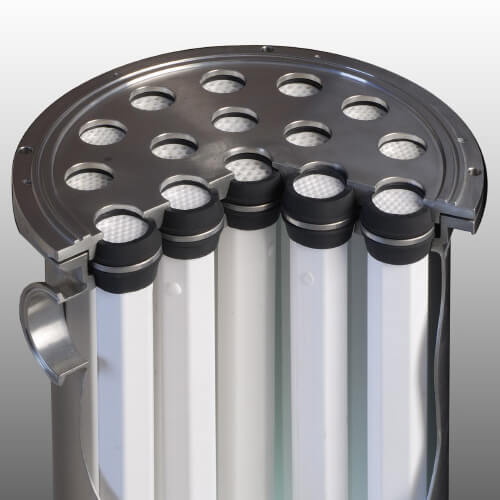High Quality Enzyme Recovery
Primary broth clarification is carried out by a variety of methods ranging from centrifugation to filtration. Today’s ingredient manufacturers are looking for the most cost-effective clarification solutions that will provide the highest product quality and maximum yield, while ensuring process safety and minimizing waste volumes.
Membralox® ceramic crossflow technology enables reliable, high quality filtrate regardless of broth characteristics. Unlike centrifugation, where cell size and density as well as fluid viscosity influence the separation efficiency, membrane separation offers an absolute physical barrier that will always provide the optimum separation.
Ceramic crossflow technology also provides a solution which can operate without incurring the storage, handling and waste typical of filter aid-based pre-coat technology like RVDF systems. Furthermore, downstream of an RVDF unit, a particle filter is necessary to remove the DE that may bleed or unload. This step is not required if Membralox ceramic membranes are employed.
Additionally, when using crossflow membranes for fermentation broth clarification, the transmission of enzymes through the membranes is critical. As a result, not all membranes are suitable. To achieve optimal yield, membranes should be operated at high shear and very low TMP. Pall’s Membralox GP membranes with a permeability gradient built into the support structure are designed specifically for maximum enzyme transmission.
Membralox ceramic filtration modules consist of porous ceramic membrane elements, sealed in stainless steel housings with polymeric gaskets. Key features include:
- 3, 4 and 6 mm ID feed channel sizes available in various module configurations for handling a wide range of feed streams, and allowing optimum system configuration
- Extremely robust elements using an ultra-pure underlying alpha alumina support structure, with 12 µm pore size and 33 % porosity, leading to wide chemical compatibility, high flux and suitability for continuous high temperature operation
- Filtration layers with sharp membrane pore size distribution available from open microfiltration to tight ultrafiltration
In crossflow filtration, the feed stream moves parallel to the membrane filtration surface and purified liquid passes through the membrane. The parallel flow of the feed stream, combined with the boundary layer turbulence created by the crossflow velocity, continuously sweeps away particles and other substances which would otherwise build up on the membrane surface.
As a result, crossflow filters routinely maintain higher permeate rates longer than conventional dead-end filters. Crossflow technology offers the ideal solution for handling high solids load applications.
Membralox crossflow systems offer the following benefits:
- Process flexibility due to batch system configuration
- High product recovery due to
- high solids handling capability
- capability for diafiltration or washing the concentrate with water or buffer solution post filtration to maximize yield
- Reduced cost and increased efficiency of downstream processes due to higher filtrate quality compared to centrifuge and pre-coat technologies
- Extremely long membrane service life due to ceramic element construction
- Reduced operator exposure and maximum product protection due to a fully enclosed design
- Reduced process maintenance and waste due to absence of filter aids
- Process simplicity, reliability and safety due to system automation
- Space savings due to compact system footprint




